
The Indonesian National Revolution, or the Indonesian War of Independence, was an armed conflict and diplomatic struggle between the Republic of Indonesia and the Dutch Empire and an internal social revolution during postwar and postcolonial Indonesia. It took place between Indonesia's declaration of independence in 1945 and the Netherlands' recognition of Indonesia's independence at the end of 1949.
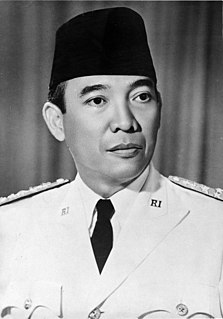
Sukarno was an Indonesian statesman, politician, nationalist and revolutionary who was the first president of Indonesia, serving from 1945 to 1967.

Mohammad Hatta was an Indonesian statesman who served as the country's first vice president. Known as "The Proclamator", he and a number of Indonesians, including the first president of Indonesia, Sukarno, fought for the independence of Indonesia from the Dutch. Hatta was born in Fort de Kock, Dutch East Indies. After his early education, he studied in Dutch schools in the Dutch East Indies and studied in the Netherlands from 1921 until 1932.
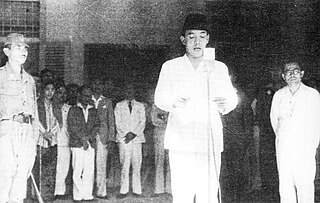
The Proclamation of Indonesian Independence was read at 10:00 am on Friday, 17 August 1945. The declaration marked the start of the diplomatic and armed resistance of the Indonesian National Revolution, fighting against the forces of the Netherlands and pro-Dutch civilians, until the latter officially acknowledged Indonesia's independence in 1949. The document was signed by Sukarno and Mohammad Hatta, who were appointed president and vice-president respectively the following day.
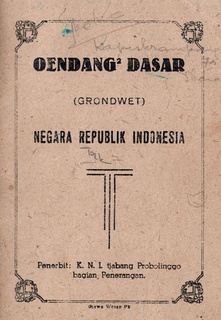
The 1945 State Constitution of the Republic of Indonesia is the basis for all laws of Indonesia.

Bengkulu is the capital of the Indonesian province of Bengkulu. The city is the second largest city on the west coast of Sumatra Island after Padang. Previously this area is under the influence of the kingdom of Inderapura and the Sultanate of Banten. The city also became the exile of Sukarno during the period of 1939 - 1942. It covers an area of 151.70 km2 and had a population of 308,544 at the 2010 Census and 373,591 at the 2020 Census. The city is also the largest city of Bengkulu Province.

Mohammad Yamin was an Indonesian poet, politician and national hero who played a key role in the writing of the draft preamble to the 1945 constitution.

This is the Timeline of Indonesian National Revolution (1945–1950)

The Preparatory Committee for Indonesian Independence , or PPKI was a body established on 7 August 1945 to prepare for the transfer of authority from the occupying Japanese to Indonesia. It approved and promulgated the first Indonesian constitution, and appointed Sukarno president.
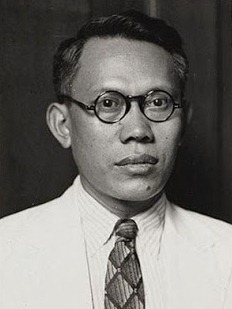
Sjafruddin Prawiranegara was an Indonesian statesman and economist. He served as the head of government in the Emergency Government of the Republic of Indonesia, as Minister of Finance in several cabinets, and was the first Governor of Bank Indonesia between 1951 and 1958. He was also the prime minister of the Revolutionary Government of the Republic of Indonesia.
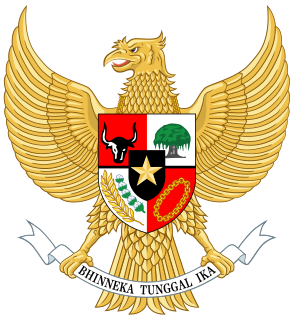
The Presidential Cabinet was the first cabinet established by Indonesia following the 17 August 1945 Indonesian Declaration of Independence. It comprised 20 ministers and four officials. Its term of office ran from 2 September to 14 November 1945.

Sjafruddin Prawiranegara's Emergency Cabinet was the government of the Emergency Government of the Republic of Indonesia (PDRI), effectively Indonesia's government-in-exile, established in Bukittinggi, West Sumatra following the second Dutch military aggression when the republican capital of Yogyakarta was seized and most of the cabinet allowed itself to be captured in the hope of attracting sympathy from the outside world.

The Natsir Cabinet was the first cabinet formed after the dissolution of the United Republic of Indonesia and returned to the Unitary State of the Republic of Indonesia. This cabinet was in charge from 6 September 1950 – 20 March 1951.

Teuku Muhammad Hasan was an Indonesian politician. He served as the first Governor of Sumatra after Indonesian Independence in 1945. He also served as Deputy Chairman, of the Home Affairs, Education & Culture and Religious Affairs in Sjafruddin Prawiranegara's Emergency Cabinet.

The State of East Sumatra was established by the Netherlands after the reoccupation of North Sumatra in July, 1947, during the first of the Dutch "police actions" against the fledgling Republic of Indonesia. In 1949, as part of a peace deal that concluded the Indonesian National Revolution, it joined the United States of Indonesia, of which the Republic was also a component state. In August, 1950, it was absorbed into the Republic as part of the province of North Sumatra. The area covered by the former state included the present-day regencies of Langkat, Deli Serdang, Serdang Bedagai, Karo, Simalungan, Batubara and Asahan, together with the cities geographically within those regencies.

I Gusti Ketut Pudja was an Indonesian politician and national hero, who served as the first governor of Lesser Sunda from 1945 until 1946. He was a member of the Investigating Agency for Preparatory Work for Indonesian Independence (BPUPK). He was also present at Admiral Tadashi Maeda's house, during the preparation for the Proclamation of Indonesian Independence on 17 August 1945. Making him the only Balinese to be present during the proclamation.
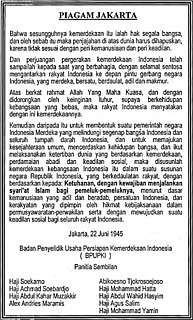
The Jakarta Charter was a document drawn up by members of the Indonesian Investigating Committee for Preparatory Work for Independence (BPUPK) on 22 June 1945 in Jakarta that later formed the basis of the preamble to the Constitution of Indonesia. The document contained the five principles of the Pancasila ideology, but it also included an obligation for Muslims to abide by Shariah law. This obligation, which was also known as the "Seven Words", which was eventually deleted from the enacted constitution after the Indonesian declaration of independence on August 18, 1945. Following the deletion of the "Seven Words" efforts by Islamic parties continued for the inclusion of the "Seven Words." Most notably in 1959, when the 1945 constitution was suspended, in 1968, during the Transition to the New Order, and in 2002, following the end of the New Order and the beginning of the Reformasi era.

Colonel Maludin Simbolon was an Indonesian military figure, independence fighter, and Minister of Foreign Affairs in the Revolutionary Government of the Republic of Indonesia's (PRRI) Cabinet.

Mr. Sutan Mohammad Amin Nasution, also known by his birth name Krueng Raba Nasution was an Acehnese–Mandailing lawyer and politician.

The Governor of North Sumatra is the highest office in the province of North Sumatra. The governor of North Sumatra is an elected official who is responsible for leading the government in North Sumatra, proposing and enacting regional laws, and representing the North Sumatra province inside and outside the court. The governor alongside the deputy governor and 100 members of the Regional People's Representative Council are accountable for the strategic government of the province of North Sumatra.


















